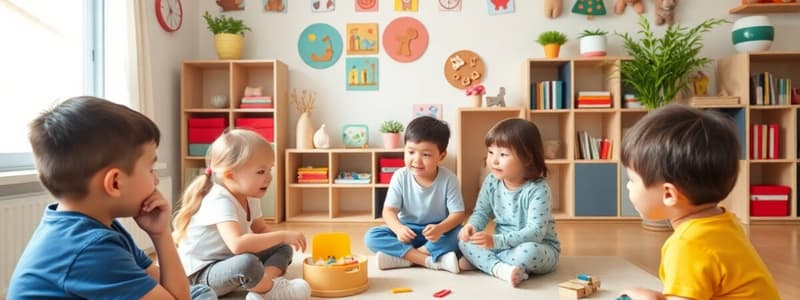Podcast
Questions and Answers
How do neutral colors contribute to a home-like atmosphere in a school-age care program?
How do neutral colors contribute to a home-like atmosphere in a school-age care program?
- They create a visually stimulating environment.
- They reduce the need for other decorations.
- They stimulate creativity and excitement.
- They provide a soothing backdrop for displaying children's work. (correct)
What is the primary purpose of using baskets and containers in a school-age care setting?
What is the primary purpose of using baskets and containers in a school-age care setting?
- To create visually appealing decorations.
- To limit the amount of materials available to children.
- To promote a neat and organized environment and minimize clutter. (correct)
- To separate different activity areas.
According to Loris Malaguzzi, what role should the environment play in reflecting the people who inhabit it?
According to Loris Malaguzzi, what role should the environment play in reflecting the people who inhabit it?
- A kind of aquarium which reflects the ideas, ethics, attitudes and lifestyle of the people. (correct)
- A functional space that meets basic needs.
- A learning space
- A space that is easy to clean and maintain.
In a shared space for school-age programs, what is a significant challenge regarding environmental ownership?
In a shared space for school-age programs, what is a significant challenge regarding environmental ownership?
Why is incorporating the natural world into the classroom important for creating a home-like atmosphere?
Why is incorporating the natural world into the classroom important for creating a home-like atmosphere?
What is a disadvantage of shared spaces?
What is a disadvantage of shared spaces?
Which of the following best exemplifies the use of materials that reflect children's home environments?
Which of the following best exemplifies the use of materials that reflect children's home environments?
Why is it important for school-age care programs to avoid replicating an institutional environment?
Why is it important for school-age care programs to avoid replicating an institutional environment?
In the context of creating a home-like atmosphere, what does 'making materials accessible to the children' primarily involve?
In the context of creating a home-like atmosphere, what does 'making materials accessible to the children' primarily involve?
What is the impact of having to set up and dismantle an environment daily in a shared space?
What is the impact of having to set up and dismantle an environment daily in a shared space?
How does the use of actual tools and machines that children might have at home contribute to a home-like atmosphere?
How does the use of actual tools and machines that children might have at home contribute to a home-like atmosphere?
In a shared space, what is a major health and safety concern?
In a shared space, what is a major health and safety concern?
What is the benefit of using flexible materials and loose parts in a school-age care program?
What is the benefit of using flexible materials and loose parts in a school-age care program?
How does using soft lighting contribute to a home-like atmosphere?
How does using soft lighting contribute to a home-like atmosphere?
What could potentially result from poorly designed space?
What could potentially result from poorly designed space?
What is the significance of ensuring materials are interesting and challenging in a school-age care program?
What is the significance of ensuring materials are interesting and challenging in a school-age care program?
What is the primary reason for incorporating soft and cozy furnishings in a school-age care program?
What is the primary reason for incorporating soft and cozy furnishings in a school-age care program?
Which of the following is a strategy to address physical space constraints?
Which of the following is a strategy to address physical space constraints?
What is the main impact of limited access to space outside normal program hours in a shared space?
What is the main impact of limited access to space outside normal program hours in a shared space?
Considering the shared space constraints, what is one strategy that could help?
Considering the shared space constraints, what is one strategy that could help?
Flashcards
Ideal school-age care program atmosphere
Ideal school-age care program atmosphere
A comfortable, home-like setting that allows for solitary and social, active and quiet learning experiences.
Elements of a Home-Like Atmosphere
Elements of a Home-Like Atmosphere
Incorporate soft furnishings, diversity in materials, natural elements, and flexible materials.
Reflective Materials
Reflective Materials
Materials, books, and photos that reflect the children's backgrounds, culture, language, and heritage.
Incorporate Natural Materials
Incorporate Natural Materials
Signup and view all the flashcards
Use Familiar Tools
Use Familiar Tools
Signup and view all the flashcards
Neutral Colors
Neutral Colors
Signup and view all the flashcards
Organized Environment
Organized Environment
Signup and view all the flashcards
Environment as a Reflection
Environment as a Reflection
Signup and view all the flashcards
Shared Space
Shared Space
Signup and view all the flashcards
Challenges of Shared Space
Challenges of Shared Space
Signup and view all the flashcards
Display Constraints
Display Constraints
Signup and view all the flashcards
Poorly Designed Space
Poorly Designed Space
Signup and view all the flashcards
Lack of Safe Space
Lack of Safe Space
Signup and view all the flashcards
Safety and Health Issues
Safety and Health Issues
Signup and view all the flashcards
Daily Setup and Dismantle
Daily Setup and Dismantle
Signup and view all the flashcards
Study Notes
- The best-designed rooms can fail if they do not imitate the appropriate atmosphere.
- School-age care programs should be comfortable and home-like instead of an institutional environment.
- These programs should allow for a range of solitary and social, active and quiet learning experiences.
Creating a Home-Like Atmosphere
- Use materials that reflect children's home environments.
- Incorporate soft, cozy furnishings to encourage rest and relaxation.
- Include materials, books, and photos that reflect the diversity of the children's backgrounds, cultures, languages, and heritage.
- Incorporate natural materials throughout the room to reflect both the children and their natural surroundings.
- Use beach rocks, driftwood, plants, shells, natural wood furnishings, and wicker baskets.
- Use actual tools and machines that children might have at home.
- Make materials accessible to the children.
- Use flexible materials and loose parts.
- Use soft lighting.
- Ensure the materials are interesting and challenging.
- Use soothing neutral colors as a backdrop for displaying children’s work and photos.
- Use baskets and containers to minimize clutter and provide easy storage, promoting a neat and organized environment.
- The environment should reflect the ideas, ethics, attitudes, and lifestyle of the people living in it.
Sharing Space Challenges
- Many school-age programs are located in spaces shared with other users, often designed for different purposes.
- Challenges of shared spaces include:
- Inability to take ownership over the environment.
- Constraints by the property owner on activities.
- Poorly designed space for supervision, washroom access, and kitchen facilities.
- Lack of storage space.
- Lack of safe space to maintain projects over time.
- Safety and health issues from remnants left by other tenants.
- Limited access to the space outside normal program hours.
- Having to set up and dismantle the environment daily, often with children present.
Studying That Suits You
Use AI to generate personalized quizzes and flashcards to suit your learning preferences.




